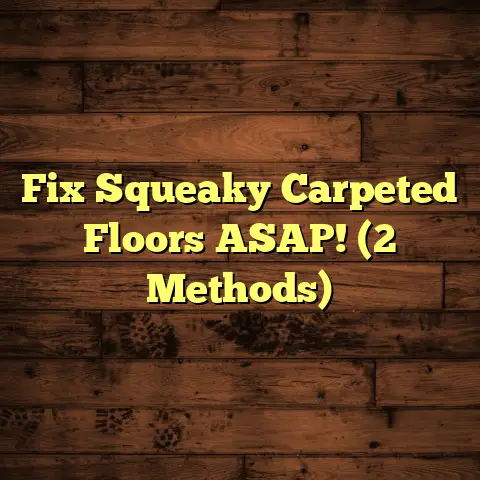Fix Wood Floor Holes Fast (4 Easy Hacks!)
Let’s talk about wood floors.
There’s nothing quite like the warm, inviting feel of real wood underfoot.
I’ve spent years installing, repairing, and restoring these beauties, and I can tell you, they’re worth the investment.
Imagine a cozy living room, sunlight streaming across perfectly polished hardwood, the scent of lemon oil lingering in the air.
Now, picture this:
A family gathering, laughter echoing, and then… a sudden stumble.
Someone’s shoe caught in a sneaky little hole, hidden just beneath the surface of your otherwise pristine floor.
Embarrassing, right?
And potentially dangerous!
Those little imperfections, those holes and gouges, aren’t just unsightly; they can be a real pain.
They can trip people, collect dirt, and even signal bigger problems lurking beneath the surface.
That’s why addressing them quickly and effectively is so important.
But don’t worry, you don’t need to rip up your entire floor or spend a fortune on a professional (unless, of course, the damage is extensive).
I’m here to share four easy, practical hacks that I’ve used countless times to fix wood floor holes fast.
These are tried-and-true methods that I’ve honed over the years, and I’m confident they’ll help you restore your floors to their former glory.
So, grab your toolbox, and let’s get started! We’re about to transform your floors from damaged to dazzling.
Understanding the Types of
Holes in Wood Flooring
Before we dive into the fixes, let’s talk about the holes themselves.
Not all holes are created equal, and understanding what you’re dealing with is crucial for choosing the right approach.
Common Causes of Holes
So, what causes these pesky holes to appear in our beloved wood floors?
Well, there are a few common culprits:
-
Termite Damage:
These tiny wood-munchers can wreak havoc, leaving behind a network of tunnels and holes. According to the National Pest Management Association, termites cause over $5 billion in property damage each year in the US alone. That’s a scary statistic!
-
Water Damage:
Water is wood’s worst enemy. Leaks, spills, or even high humidity can cause wood to rot and decay, leading to holes and soft spots.
-
Natural Wear and Tear:
Over time, even the toughest wood floors can succumb to the effects of everyday life. Foot traffic, dropped objects, and shifting furniture can all contribute to wear and tear, resulting in small holes and gouges.
-
Improper Installation:
Sometimes, the problem starts before you even move in. Poorly installed floors are more susceptible to damage and may develop holes due to uneven support or improper nailing.
Identifying Different Types of Holes
Now, let’s get down to specifics.
Here are some common types of holes you might encounter:
-
Small Pinholes:
These are tiny, often barely noticeable holes that can be caused by insects, minor impacts, or simply the natural aging of the wood.
-
Larger Gouges:
These are more substantial holes, usually caused by dropped objects, scratches, or dragging furniture. They’re deeper and more visible than pinholes.
-
Structural Damage:
This is the most serious type of damage, indicating a problem with the underlying structure of the floor. These holes are often large, deep, and may be accompanied by soft spots or sagging.
Structural damage is usually caused by water damage, termite infestation, or significant impact.
Think of it like this: a pinhole is like a tiny mosquito bite, a gouge is like a scraped knee, and structural damage is like a broken bone.
You wouldn’t treat them all the same, right?
Assessing Damage Severity
Okay, so you’ve identified a hole in your wood floor. Now what?
The next step is to assess the severity of the damage to determine whether you can tackle it yourself or if you need to call in a professional.
Here are some things to consider:
-
Size and Depth:
How big is the hole? How deep does it go? Smaller, shallower holes are usually easier to fix than larger, deeper ones.
-
Location:
Where is the hole located? Holes in high-traffic areas or near walls may require more attention to detail to ensure a seamless repair.
-
Underlying Damage:
Is there any evidence of water damage, rot, or insect infestation? If so, you’ll need to address the underlying cause before you can repair the hole.
-
Your Skill Level:
Be honest with yourself about your DIY skills. If you’re not comfortable working with power tools or handling wood filler, it’s best to leave the job to a professional.
When to DIY:
- Small pinholes and gouges
- Superficial damage
- You’re comfortable with basic woodworking tools
When to Call a Professional:
- Large or deep holes
- Structural damage
- Evidence of water damage or insect infestation
- You’re not comfortable with DIY repairs
Remember, it’s always better to err on the side of caution.
If you’re unsure about anything, consult with a qualified flooring contractor.
Trust me, it’s worth the investment to ensure the job is done right and to prevent further damage to your floors.
Now that we’ve covered the basics, let’s get to those hacks!
Hack #1 – Wood Filler for Small Holes
Alright, let’s start with the easiest and most common fix: wood filler.
This is my go-to solution for small pinholes and gouges, and it’s something almost anyone can do.
Materials Needed
Before you get started, gather your supplies:
-
Wood Filler:
Choose a wood filler that matches the color of your floor as closely as possible. You can find wood filler at most hardware stores. I prefer stainable wood filler so you can customize the color.
-
Putty Knife:
A small, flexible putty knife is essential for applying the filler smoothly and evenly.
-
Sandpaper:
You’ll need sandpaper in various grits (e.g., 120, 220) for smoothing the filler and blending it with the surrounding wood.
-
Finish:
You’ll need a finish that matches your existing floor finish to seal the filler and protect it from wear and tear.
-
Cleaning Supplies:
A vacuum cleaner or broom and a damp cloth for cleaning the area around the hole.
Step-by-Step Instructions
Here’s how to use wood filler to fix small holes in your wood floor:
-
Clean the Area:
Start by thoroughly cleaning the area around the hole. Remove any dirt, dust, or debris with a vacuum cleaner or broom. Then, wipe the area with a damp cloth to remove any remaining residue. Make sure the area is completely dry before proceeding.
-
Apply the Filler:
Using your putty knife, scoop up a small amount of wood filler and apply it to the hole. Press the filler firmly into the hole, making sure to fill it completely.
Overfill the hole slightly, as the filler will shrink as it dries.
-
Smooth the Surface:
Use the putty knife to smooth the surface of the filler, blending it with the surrounding wood. Remove any excess filler and try to create a seamless transition between the filler and the floor.
-
Allow it to Dry:
Let the filler dry completely according to the manufacturer’s instructions. This usually takes several hours or even overnight.
-
Sand it Down:
Once the filler is dry, use sandpaper to smooth the surface and blend it with the surrounding wood. Start with a coarser grit (e.g., 120) to remove any excess filler, then switch to a finer grit (e.g., 220) to create a smooth, even finish.
-
Finish with Stain or Sealant:
Apply a stain or sealant that matches your existing floor finish. This will protect the filler from wear and tear and help it blend in with the surrounding wood. Follow the manufacturer’s instructions for applying the finish.
Tips for Best Results
Here are a few insider tips for achieving a seamless finish:
-
Color Matching:
This is crucial for a successful repair. If you can’t find a wood filler that perfectly matches your floor, you can mix different colors of filler together to create a custom blend. You can also use a stainable wood filler and stain it to match your floor.
-
Blending Techniques:
To blend the filler seamlessly with the surrounding wood, try feathering the edges of the filler with your putty knife. This will create a gradual transition between the filler and the floor.
-
Multiple Coats:
For deeper holes, you may need to apply multiple coats of filler, allowing each coat to dry completely before applying the next.
-
Patience is Key:
Don’t rush the process. Take your time to apply the filler smoothly, sand it evenly, and finish it properly. The more time you spend on the repair, the better the results will be.
Visuals
(Include before and after photos or illustrations here to show the process of using wood filler to fix small holes.)
Hack #2 – Using a Wood Plug for
Larger Holes
Okay, so wood filler is great for small holes, but what about larger ones?
That’s where wood plugs come in handy.
What is a Wood Plug?
A wood plug is a small, cylindrical piece of wood that’s designed to fill larger holes in wood floors.
They’re typically made of the same type of wood as your floor and can be purchased at most hardware stores.
Wood plugs are a great option for holes that are too large for wood filler but not large enough to require a more extensive repair.
Materials Needed
Here’s what you’ll need to install a wood plug:
-
Wood Plug Kit:
This kit typically includes a selection of wood plugs in various sizes, a plug cutter (a special drill bit for creating perfectly sized holes), and wood glue.
-
Drill:
You’ll need a drill to create a hole that’s the same size as the wood plug.
-
Wood Glue:
Wood glue is essential for securing the plug in place.
-
Sandpaper:
You’ll need sandpaper to smooth the plug and blend it with the surrounding wood.
-
Finish:
You’ll need a finish that matches your existing floor finish to seal the plug and protect it from wear and tear.
Step-by-Step Instructions
Here’s how to install a wood plug:
-
Drill Out the Hole:
Using the plug cutter from your wood plug kit, drill out the hole to create a perfectly sized opening for the plug. Make sure to drill straight down and avoid angling the drill.
-
Insert the Plug with Glue:
Apply a generous amount of wood glue to the inside of the hole and to the sides of the wood plug. Insert the plug into the hole and tap it gently with a hammer to ensure it’s fully seated.
-
Allow the Glue to Dry:
Let the glue dry completely according to the manufacturer’s instructions. This usually takes several hours or even overnight.
-
Sand and Finish the Area:
Once the glue is dry, use sandpaper to smooth the plug and blend it with the surrounding wood. Start with a coarser grit (e.g., 120) to remove any excess wood, then switch to a finer grit (e.g., 220) to create a smooth, even finish. Apply a finish that matches your existing floor finish to seal the plug and protect it from wear and tear.
Visuals
(Include diagrams or images of the process to assist readers in visualizing each step.)
Hack #3 – Epoxy for Structural Damage
Now, let’s talk about the big guns: epoxy.
This is my go-to solution for structural damage or larger holes that require a more robust repair.
Understanding Epoxy
Epoxy is a two-part resin that, when mixed together, creates a strong, durable, and waterproof bond.
It’s ideal for repairing structural damage in wood floors because it can fill large voids, reinforce weakened areas, and prevent further decay.
Materials Needed
Here’s what you’ll need to use epoxy:
-
Epoxy Resin:
Choose a high-quality epoxy resin that’s specifically designed for wood repair.
-
Hardener:
The hardener is the catalyst that causes the epoxy resin to cure. Make sure to use the correct hardener for your epoxy resin.
-
Mixing Tools:
You’ll need a mixing container and a mixing stick to combine the epoxy resin and hardener.
-
Protective Gear:
Epoxy can be harmful if it comes into contact with your skin or eyes, so it’s important to wear gloves, eye protection, and a respirator when working with it.
Step-by-Step Instructions
Here’s how to use epoxy for larger or structural holes:
-
Prepare the Area:
Thoroughly clean the area around the hole, removing any loose wood, dirt, or debris. You may need to use a chisel or scraper to remove any rotted or damaged wood.
-
Mix and Apply the Epoxy:
Follow the manufacturer’s instructions for mixing the epoxy resin and hardener. Be sure to mix the two components thoroughly and in the correct proportions. Apply the epoxy to the hole, filling it completely. You may need to apply multiple coats of epoxy to fill larger voids.
-
Allow it to Cure:
Let the epoxy cure completely according to the manufacturer’s instructions. This usually takes several hours or even overnight.
-
Finish the Surface:
Once the epoxy is cured, use sandpaper to smooth the surface and blend it with the surrounding wood. Apply a finish that matches your existing floor finish to seal the epoxy and protect it from wear and tear.
Visuals
(Use detailed images to illustrate the process and results of using epoxy for repairs.)
Hack #4 – Creative Solutions for
Unconventional Holes
Sometimes, you encounter holes that are just too large, too awkwardly placed, or too… well, unconventional to fix with traditional methods.
That’s when it’s time to get creative!
Using Decorative Elements
Here are some creative ways to cover holes that are too large or in awkward places:
-
Using Decorative Inlays:
You can create a custom inlay using a contrasting wood, metal, or even stone to cover the hole. This can add a unique and artistic touch to your floor.
-
Installing a Rug or Furniture Strategically:
Sometimes, the simplest solution is the best. A strategically placed rug or piece of furniture can effectively cover the hole and prevent it from being a tripping hazard.
-
Creating a Wood Art Piece that Incorporates the Hole:
If you’re feeling particularly artistic, you can create a wood art piece that incorporates the hole as part of the design. This can be a fun and creative way to turn a flaw into a feature.
Materials Needed
The materials you’ll need will depend on the specific creative solution you choose.
Here are some common items:
-
Decorative Inlay Materials:
Contrasting wood, metal, stone, tile, adhesive, grout (if using tile).
-
Rug or Furniture:
Choose a rug or piece of furniture that complements your existing decor.
-
Wood Art Supplies:
Wood scraps, paint, stain, glue, saw, sandpaper.
Step-by-Step Instructions
The instructions for implementing these creative fixes will vary depending on the specific solution you choose.
Here are some general tips:
-
Plan Your Design:
Before you start, sketch out your design and measure the hole carefully. This will help you determine the size and shape of the inlay, rug, or art piece you need.
-
Prepare the Area:
Clean the area around the hole thoroughly and remove any loose wood or debris.
-
Be Creative and Have Fun:
This is your chance to let your imagination run wild! Don’t be afraid to experiment with different materials and designs.
Visuals
(Share inspiring photos of innovative solutions to encourage readers to think outside the box.)
Conclusion
So, there you have it: four easy hacks for fixing wood floor holes fast!
From simple wood filler to creative decorative solutions, there’s a method for every type of hole and every skill level.
Remember, maintaining the integrity of your wood floors is essential for preserving their beauty, durability, and value.
And there’s nothing quite as satisfying as tackling a DIY repair and seeing the amazing results of your hard work.
I’ve seen countless homeowners transform their floors from damaged to dazzling using these simple techniques.
And I know you can too!
So, go ahead, grab your toolbox, and get started.
With the right tools and techniques, you can tackle any flooring challenge that comes your way.
And if you ever get stuck, don’t hesitate to reach out to a qualified flooring contractor.
We’re always here to help!
Now go make those floors shine!





